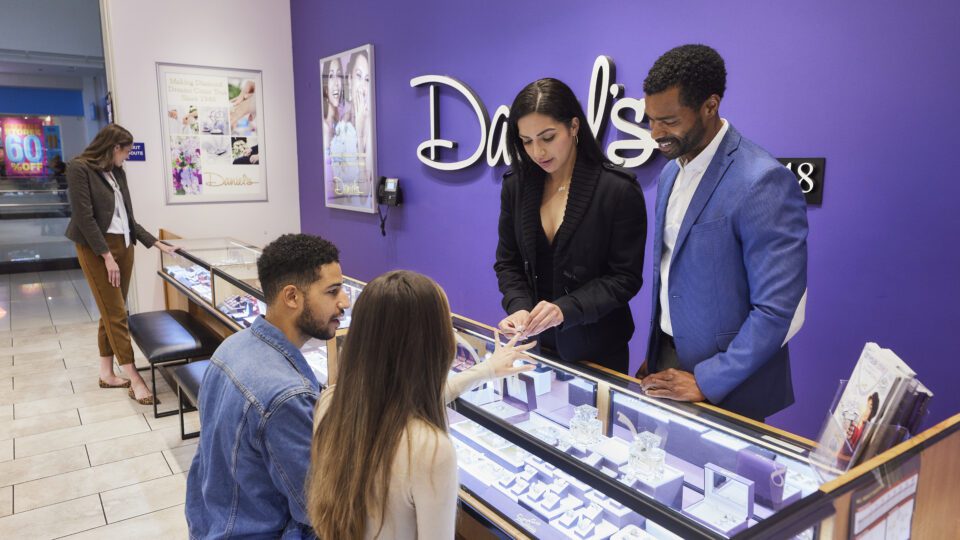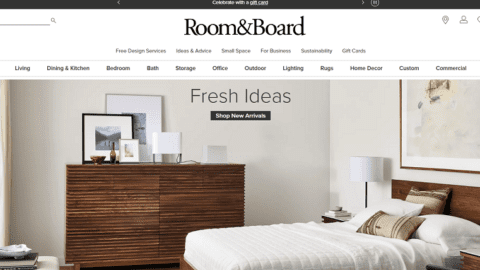In the more than 70 years since Joseph Sherwood bought a bankrupt jewelry store in Bell Gardens, Calif., much has changed in the world, and in retail. That post-WWII period in the Western U.S. was marked by the Dust Bowl Exodus, now a distant memory for most. Since then, the demographic makeup of California has changed dramatically, not to mention the economic and technological realities of the state and the country. Daniel’s Jewelers has been at the center of it all, although from the perspective of Sherwood’s grandson David, who now runs the company, the things that matter most have changed very little over the decades.
“We still have our first store in Bell Gardens, and in that store the merchandise is still diamonds and gold; the styles have changed a little bit, but it’s still relatively the same,” said CEO David Sherwood in an interview with Retail TouchPoints. “Our customer is still a migrant, but now they are [more likely] an immigrant, so they don’t come from the Midwest, they come from south of the border. Instead of a Midwestern twang maybe they have a Spanish accent, but their dreams, their hopes, what they want to accomplish, what jewelry means to them has not changed one iota in the last 75 years.”
One thing that has changed, though, is how Sherwood and his team are equipping themselves to meet the needs of those customers. One prime example: the retailer’s partnership with RetailNext to use in-store traffic analytics for shaping everything from staffing strategies to improving store performance and even loss prevention. Sherwood took Retail TouchPoints behind the scenes of the chain’s technology and service evolution as it continues to grow across the West.
Falling Back in Love with the Business He’d Grown Up In
Since the acquisition of that first store in 1954, Daniel’s Jewelers has slowly grown through three generations of the Sherwood family, now encompassing 107 locations across six states, from California to Florida. When David Sherwood joined the family business in 2001, the plan was to sell. His father and uncle, who were running the company at that time, were ready to retire, so David was brought in to help find a buyer. But in the process, he fell back in love with the business he had grown up in, and the plan changed.
Advertisement
“I was working with various people [to prepare for a sale], and these were people who knew me when I was 6 years old,” Sherwood recounted. “My first job was scraping gum off the sidewalk with a 20-year-old maintenance guy who lived behind the main office; he had now become the maintenance director. When I was 8, I would tag merchandise with this really nice woman who now ran the distribution department. I learned to collect accounts from this grumpy old dude, who is now the grumpy old dude running our collections. All these people were uncles and aunts to me growing up and I just sort of fell back in love with these people and stayed. And as I got more involved, I realized that what it was worth then was not what it could be worth, and there was still so much more opportunity.”
‘With Growth Comes Complexity’
Sherwood has followed through on that vision, leading the company through its most dramatic period of growth since its inception, nearly tripling the chain’s store count. Along with that growth has come increased complexity, of course, which has necessitated changes in the way the business runs.
“It’s gone from my grandfather just sort of exalting from on high how things were going to be, to my dad and uncle beginning to build teams, to me with even more departments and more people involved — it’s more management than it is entrepreneurship at this point,” Sherwood said. “But at the end of the day what we do at the store level, what happens with an associate and a customer over the counter, hasn’t changed at all since 1954.”
Even if what they do hasn’t changed, how they do it has, and one of the most recent ways is with the incorporation of vision AI tools from RetailNext. While Daniel’s had done store traffic counting before in “the traditional way” — by counting things like transactions and the number of credit payments made —Sherwood said “that is such a gross estimation; you have no idea of how many people actually came in.”
So the first use case for the RetailNext in-store tracking analytics was simply to get a more accurate picture of store conversion rates, based on the actual number of people that entered the store versus the number who made a purchase. “That’s the easiest and most logical use of the technology, but as soon as you start using it for that, it leads you down the path of so many other things,” said Sherwood.
Smart Staffing to Improve Outcomes

The RetailNext technology uses computer vision technology to anonymously track visitors throughout their time in a store environment, measuring not just the number of people who come in but also how they move through the store and where they stop and dwell. The cameras are placed top-down so that no faces or other personally identifiable information are collected, and while the record of their path into and through the store is available forever, the actual video footage is only stored for 15 to 30 days. Keeping that live footage available for a short period of time allows retailers to go deeper and gather additional intel when data and charts won’t suffice.
Beyond simply tracking store conversion more accurately, Sherwood gave a number of examples of how he and his team are now using this information to inform and localize their store strategy, in particular for staffing.
Since its beginnings, Daniel’s Jewelers had given its store managers Sundays off. “We looked at sales, and chainwide Sunday is not a great day for us, so it made sense to have managers take off,” explained Sherwood. “But when you break it down by store, [it turns out] there is a good portion of our chain where Sunday is a great day, and in fact, other days that we thought were great days in certain stores aren’t.” Based on this information, Daniel’s began shifting around store managers’ schedules to make sure they were in their store on peak days, whatever those days were.
That same staffing philosophy began to trickle down to top sales associates, ensuring that the best salespeople were working on high-traffic days, and has even translated to the time that associates take lunch, which is now no longer based on an arbitrary time frame but rather on the moment in the day with the biggest traffic lull.
Joe Shasteen, Global Manager of Advanced Analytics at RetailNext, explained how this kind of intel can translate even further into store operations strategies: “You can take two stores with identical sales volumes, and looking just at sales data you would think those stores are comparable, but when you layer in that traffic data, you might find that one of those stores is converting significantly higher than the other,” he said in an interview with Retail TouchPoints. “So then you start to realize that actually one of these stores has more opportunity, and the other one might be maxing out its opportunity. I’ve seen this in countless instances [with clients] and this is why retailers need to start staffing to traffic as opposed to the lagging indicator of sales. Because maybe you’re staffing your not-as-effective sales associates on a particular day, and in doing so you’re creating a self-fulfilling cycle of, ‘This day always looks worse from a sales perspective.’”
Unexpected Uses: Accountability and Loss Prevention
The RetailNext intel also has been useful to Daniel’s Jewelers’ regional managers, who typically oversee eight to 15 stores, sometimes hundreds of miles apart. Now, in between in-person visits, district managers can easily check the RetailNext feed to ensure that everything is running smoothly. For example, they can see whether new signage has been put up as requested and how often someone is actively working the “lease line” at the front of the store to draw in customers. “This allows the district managers to provide some real accountability, and even call BS on things they’re seeing, or not seeing,” said Sherwood.
Another unexpected use for the RetailNext camera footage has been dealing with the growing number of smash-and-grab robberies currently plaguing the jewelry business. While Daniel’s Jewelers locations are all equipped with security cameras as well as the RetailNext feeds, Sherwood said that often those security systems are harder to access quickly, so in many cases the RetailNext feed offers an easier way to quickly check what is going on in a store.
“Imagine an alarm goes off in a store in the middle of the night; this actually just happened a few weeks ago,” explained Sherwood. “Someone has to pick up the phone when the alarm company calls and decide what to do. Well, now the first thing we do is check the RetailNext cameras to see if there’s a person in the store. If not, that’s a good thing, and you can look to see if there’s anything else going on in the store, and if everything looks quiet you know it’s not urgent.”
Sherwood is even using some of the RetailNext footage of recent smash-and-grabs to work with vendors like his glass glazier as they look for ways to further harden the store against these kinds of attacks, by reviewing things like how long the glass withstands hits and what happens to the frames when they are smashed. “We have a real live example that we can use to figure out what we need to do to protect these cases for more than the one minute these guys allot themselves to steal,” said Sherwood.
Bringing it All Together to ‘Solve for the Customer’s Whole Journey’
This is just the beginning of the potential Sherwood sees for this technology. “RetailNext has some of the most advanced technology available, and it’s still kindergarten compared to where we need to go,” he said. “What excites me is what we can do when you attach large language models and other types of AI tools to it.” These could include tactics like optimizing stores’ merchandise layout on a local level based on traffic patterns, identifying customers that are about to leave the store and assigning associates in real-time to try to bring them back, and even finding ways to predict and warn associates when a theft might be about to happen.
“One of the biggest challenges is bridging the customer who walks into the store [to the online customer],” said Sherwood. “As soon as they get into the store we know a lot about what they’re doing, but that customer’s journey didn’t start when the camera picked them up. That customer’s journey likely started with a website visit or on their mobile phone or with a social media ad or a radio spot. How do you tie that all together? How do we understand the customer’s whole journey before, during and after they walk into the store? No one’s solved that yet, but the technology is now finally there to begin to think about how to solve that.”









